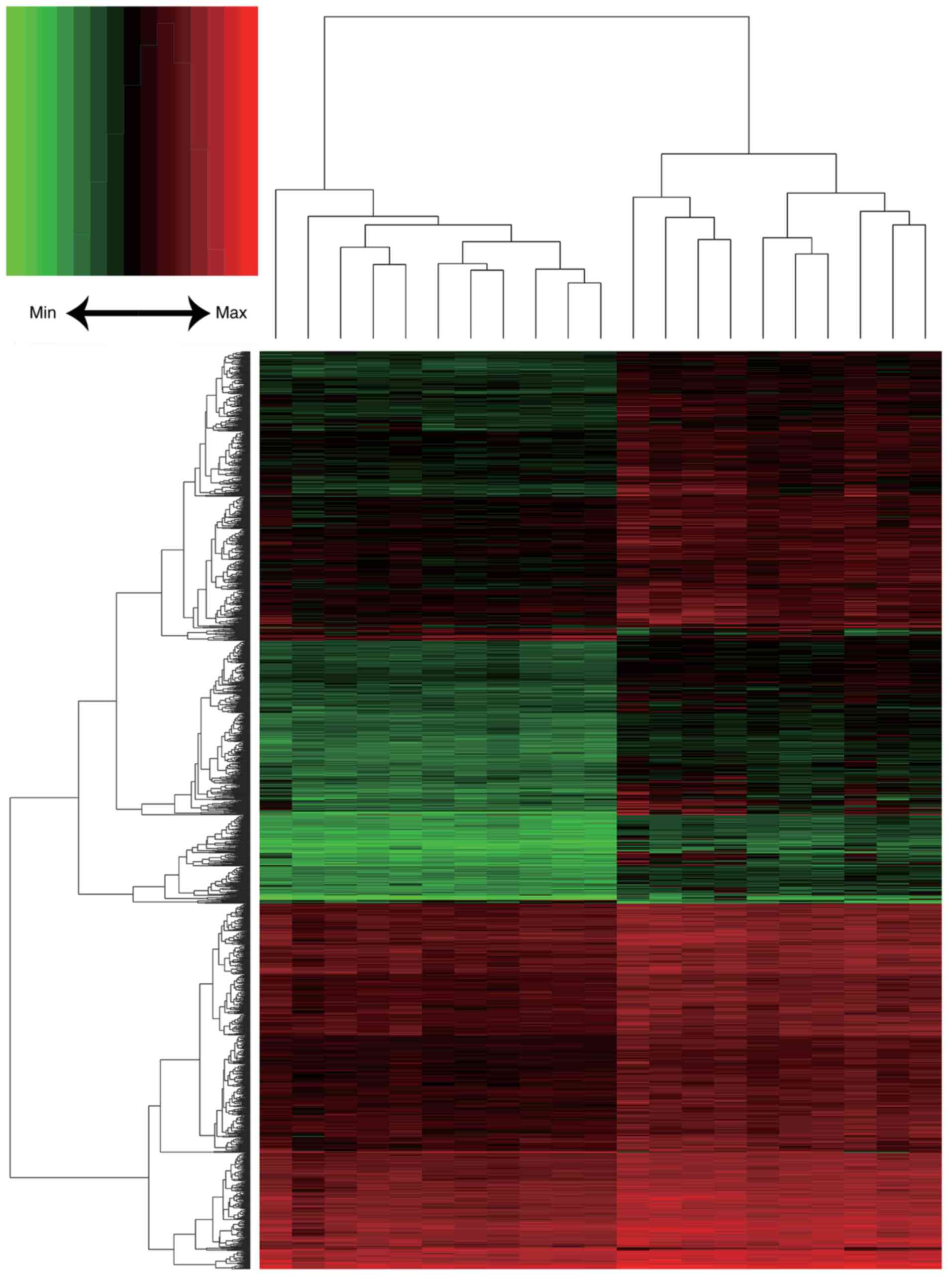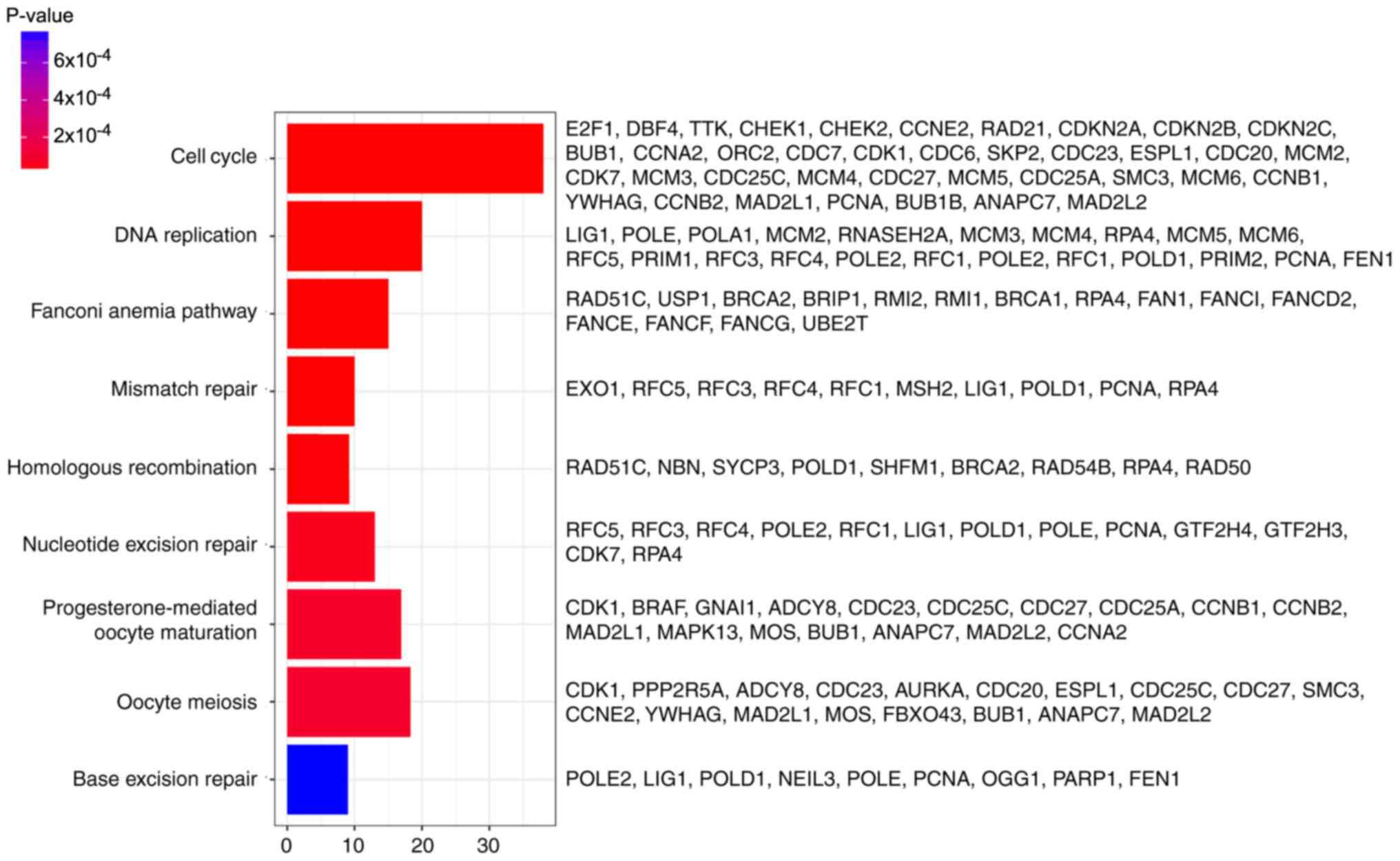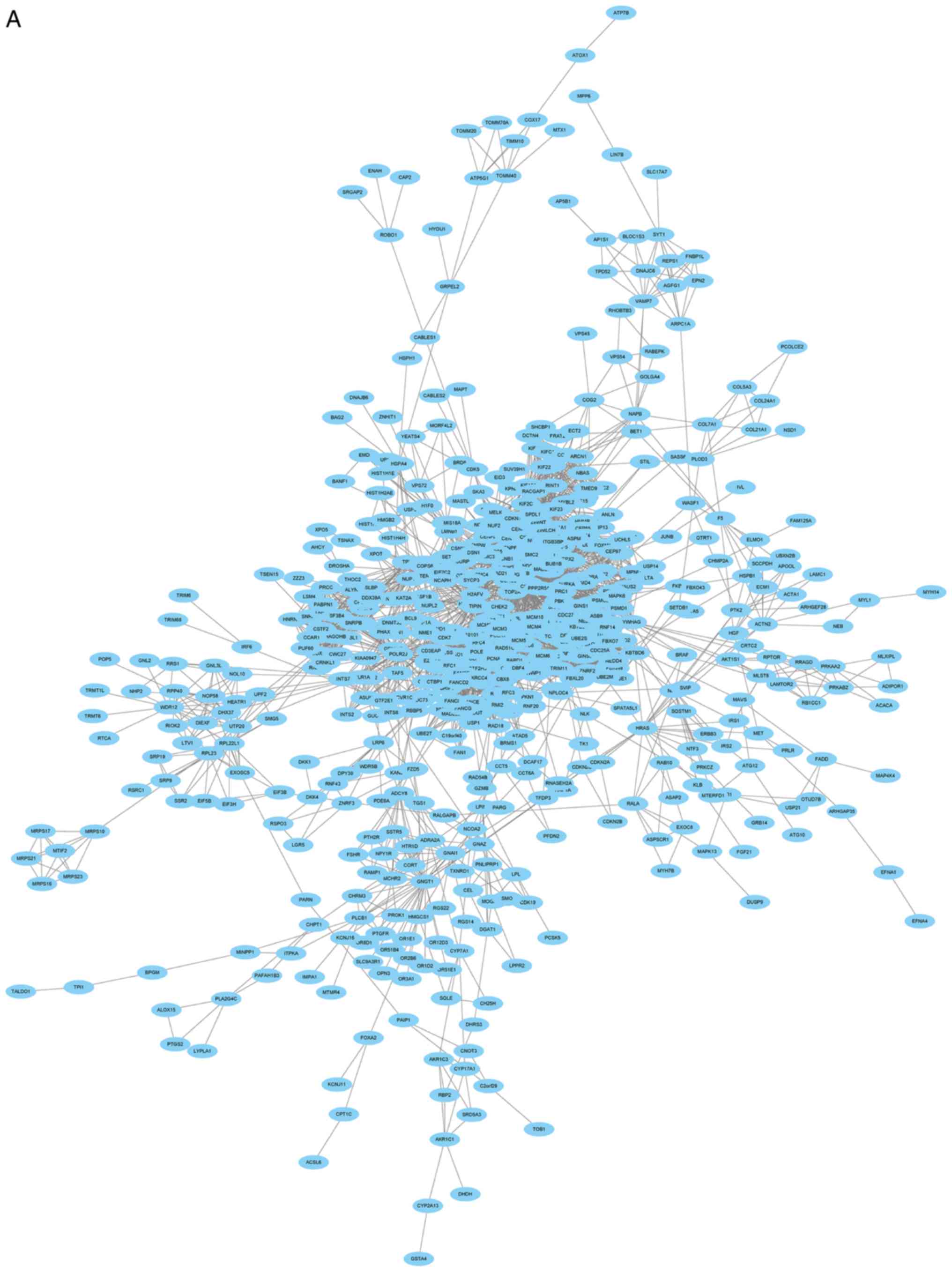|
1
|
Chen QF, Jia ZY, Yang ZQ, Fan WL and Shi
HB: Transarterial chemoembolization monotherapy versus combined
transarterial chemoembolization-microwave ablation therapy for
hepatocellular carcinoma tumors ≤5 cm: A propensity analysis at a
single center. Cardiovasc Intervent Radiol. 40:1748–1755. 2017.
View Article : Google Scholar : PubMed/NCBI
|
|
2
|
El-Serag HB: Epidemiology of viral
hepatitis and hepatocellular carcinoma. Gastroenterology.
142:1264–1273, e1. 2012. View Article : Google Scholar : PubMed/NCBI
|
|
3
|
Levrero M and Zucman-Rossi J: Mechanisms
of HBV-induced hepatocellular carcinoma. J Hepatol. 64 1
Suppl:S84–S101. 2016. View Article : Google Scholar : PubMed/NCBI
|
|
4
|
Parkin DM: The global health burden of
infection-associated cancers in the year 2002. Int J Cancer.
118:3030–3044. 2006. View Article : Google Scholar : PubMed/NCBI
|
|
5
|
Zhou HY, Luo Y, Chen WD and Gong GZ:
Hepatitis B virus mutation may play a role in hepatocellular
carcinoma recurrence: A systematic review and meta-regression
analysis. J Gastroenterol Hepatol. 30:977–983. 2015. View Article : Google Scholar : PubMed/NCBI
|
|
6
|
Intaraprasong P, Siramolpiwat S and
Vilaichone RK: Advances in management of hepatocellular carcinoma.
Asian Pac J Cancer Prev. 17:3697–3703. 2016.PubMed/NCBI
|
|
7
|
Sherman M: Hepatocellular carcinoma:
Epidemiology, surveillance, and diagnosis. Semin Liver Dis.
30:3–16. 2010. View Article : Google Scholar : PubMed/NCBI
|
|
8
|
Yildiz G, Arslan-Ergul A, Bagislar S, Konu
O, Yuzugullu H, Gursoy-Yuzugullu O, Ozturk N, Ozen C, Ozdag H,
Erdal E, et al: Genome-wide transcriptional reorganization
associated with senescence-to-immortality switch during human
hepatocellular carcinogenesis. PLoS One. 8:e640162013. View Article : Google Scholar : PubMed/NCBI
|
|
9
|
He B, Yin J, Gong S, Gu J, Xiao J, Shi W,
Ding W and He Y: Bioinformatics analysis of key genes and pathways
for hepatocellular carcinoma transformed from cirrhosis. Medicine
(Baltimore). 96:e69382017. View Article : Google Scholar : PubMed/NCBI
|
|
10
|
Irizarry RA, Hobbs B, Collin F,
Beazer-Barclay YD, Antonellis KJ, Scherf U and Speed TP:
Exploration, normalization, and summaries of high density
oligonucleotide array probe level data. Biostatistics. 4:249–264.
2003. View Article : Google Scholar : PubMed/NCBI
|
|
11
|
Gautier L, Cope L, Bolstad BM and Irizarry
RA: Affy-analysis of Affymetrix GeneChip data at the probe level.
Bioinformatics. 20:307–315. 2004. View Article : Google Scholar : PubMed/NCBI
|
|
12
|
Ashburner M, Ball CA, Blake JA, Botstein
D, Butler H, Cherry JM, Davis AP, Dolinski K, Dwight SS, Eppig JT,
et al: Gene ontology: Tool for the unification of biology. The Gene
Ontology Consortium. Nat Genet. 25:25–29. 2000. View Article : Google Scholar : PubMed/NCBI
|
|
13
|
Bader GD and Hogue CW: An automated method
for finding molecular complexes in large protein interaction
networks. BMC Bioinformatics. 4:22003. View Article : Google Scholar : PubMed/NCBI
|
|
14
|
Zhu Y, Qiu P and Ji Y: TCGA-assembler:
Open-source software for retrieving and processing TCGA data. Nat
Methods. 11:599–600. 2014. View Article : Google Scholar : PubMed/NCBI
|
|
15
|
Garnier D, Loyer P, Ribault C,
Guguen-Guillouzo C and Corlu A: Cyclin-dependent kinase 1 plays a
critical role in DNA replication control during rat liver
regeneration. Hepatology. 50:1946–1956. 2009. View Article : Google Scholar : PubMed/NCBI
|
|
16
|
Nhieu JT, Renard CA, Wei Y, Cherqui D,
Zafrani ES and Buendia MA: Nuclear accumulation of mutated
beta-catenin in hepatocellular carcinoma is associated with
increased cell proliferation. Am J Pathol. 155:703–710. 1999.
View Article : Google Scholar : PubMed/NCBI
|
|
17
|
Zhang Y, Huang W, Ran Y, Xiong Y, Zhong Z,
Fan X, Wang Z and Ye Q: miR-582-5p inhibits proliferation of
hepatocellular carcinoma by targeting CDK1 and AKT3. Tumour Biol.
36:8309–8316. 2015. View Article : Google Scholar : PubMed/NCBI
|
|
18
|
Masaki T, Shiratori Y, Rengifo W, Igarashi
K, Yamagata M, Kurokohchi K, Uchida N, Miyauchi Y, Yoshiji H,
Watanabe S, et al: Cyclins and cyclin-dependent kinases:
Comparative study of hepatocellular carcinoma versus cirrhosis.
Hepatology. 37:534–543. 2003. View Article : Google Scholar : PubMed/NCBI
|
|
19
|
Wang X, Quail E, Hung NJ, Tan Y, Ye H and
Costa RH: Increased levels of forkhead box M1B transcription factor
in transgenic mouse hepatocytes prevent age-related proliferation
defects in regenerating liver. Proc Natl Acad Sci USA.
98:11468–11473. 2001. View Article : Google Scholar : PubMed/NCBI
|
|
20
|
Wang G, Chen H, Huang M, Wang N, Zhang J,
Zhang Y, Bai G, Fong WF, Yang M and Yao X: Methyl protodioscin
induces G2/M cell cycle arrest and apoptosis in HepG2 liver cancer
cells. Cancer Lett. 241:102–109. 2006. View Article : Google Scholar : PubMed/NCBI
|
|
21
|
Sze KM, Ching YP, Jin DY and Ng IO: Role
of a novel splice variant of mitotic arrest deficient 1 (MAD1),
MAD1beta, in mitotic checkpoint control in liver cancer. Cancer
Res. 68:9194–9201. 2008. View Article : Google Scholar : PubMed/NCBI
|
|
22
|
Sze KM, Ching YP, Jin DY and Ng IO:
Association of MAD2 expression with mitotic checkpoint competence
in hepatoma cells. J Biomed Sci. 11:920–927. 2004. View Article : Google Scholar : PubMed/NCBI
|
|
23
|
Wills ES, Cnossen WR, Veltman JA,
Woestenenk R, Steehouwer M, Salomon J, Morsche Te RH, Huch M,
Hehir-Kwa JY, Banning MJ, et al: Chromosomal abnormalities in
hepatic cysts point to novel polycystic liver disease genes. Eur J
Hum Genet. 24:1707–1714. 2016. View Article : Google Scholar : PubMed/NCBI
|
|
24
|
Wang L, Huang J, Jiang M, Lin H, Qi L and
Diao H: Activated PTHLH coupling feedback phosphoinositide to
G-protein receptor signal-induced cell adhesion network in human
hepatocellular carcinoma by systems-theoretic analysis.
ScientificWorldJournal. 2012:4289792012. View Article : Google Scholar : PubMed/NCBI
|
|
25
|
Rinaudo Spiewak JA and Thorgeirsson SS:
Detection of a tyrosine-phosphorylated form of cyclin A during
liver regeneration. Cell Growth Differ. 8:301–309. 1997.PubMed/NCBI
|
|
26
|
Kim DH, Park SE, Kim M, Ji YI, Kang MY,
Jung EH, Ko E, Kim Y, Kim S, Shim YM and Park J: A functional
single nucleotide polymorphism at the promoter region of cyclin A2
is associated with increased risk of colon, liver, and lung
cancers. Cancer. 117:4080–4091. 2011. View Article : Google Scholar : PubMed/NCBI
|
|
27
|
Simile MM, De Miglio MR, Muroni MR, Frau
M, Asara G, Serra S, Muntoni MD, Seddaiu MA, Daino L, Feo F and
Pascale RM: Down-regulation of c-myc and Cyclin D1 genes by
antisense oligodeoxy nucleotides inhibits the expression of E2F1
and in vitro growth of HepG2 and Morris 5123 liver cancer cells.
Carcinogenesis. 25:333–341. 2004. View Article : Google Scholar : PubMed/NCBI
|
|
28
|
Wang J, Chenivesse X, Henglein B and
Brechot C: Hepatitis B virus integration in a cyclin A gene in a
hepatocellular carcinoma. Nature. 343:555–557. 1990. View Article : Google Scholar : PubMed/NCBI
|
|
29
|
Nault JC, Datta S, Imbeaud S, Franconi A,
Mallet M, Couchy G, Letouzé E, Pilati C, Verret B, Blanc JF, et al:
Recurrent AAV2-related insertional mutagenesis in human
hepatocellular carcinomas. Nat Genet. 47:1187–1193. 2015.
View Article : Google Scholar : PubMed/NCBI
|
|
30
|
Yang F, Hu Y, Liu HX and Wan YJ:
MiR-22-silenced cyclin A expression in colon and liver cancer cells
is regulated by bile acid receptor. J Biol Chem. 290:6507–6515.
2015. View Article : Google Scholar : PubMed/NCBI
|
|
31
|
Olson DC and Levine AJ: The properties of
p53 proteins selected for the loss of suppression of
transformation. Cell Growth Differ. 5:61–71. 1994.PubMed/NCBI
|
|
32
|
Vaughan C, Pearsall I, Yeudall A, Deb SP
and Deb S: p53: Its mutations and their impact on transcription.
Subcell Biochem. 85:71–90. 2014. View Article : Google Scholar : PubMed/NCBI
|
|
33
|
Hussain SP, Schwank J, Staib F, Wang XW
and Harris CC: TP53 mutations and hepatocellular carcinoma:
Insights into the etiology and pathogenesis of liver cancer.
Oncogene. 26:2166–2176. 2007. View Article : Google Scholar : PubMed/NCBI
|
|
34
|
Olivier M, Hollstein M and Hainaut P: TP53
mutations in human cancers: Origins, consequences, and clinical
use. Cold Spring Harb Perspect Biol. 2:a0010082010. View Article : Google Scholar : PubMed/NCBI
|
|
35
|
Wong YH, Chen RH and Chen BS: Core and
specific network markers of carcinogenesis from multiple cancer
samples. J Theor Biol. 362:17–34. 2014. View Article : Google Scholar : PubMed/NCBI
|
|
36
|
Elledge SJ: Cell cycle checkpoints:
Preventing an identity crisis. Science. 274:1664–1672. 1996.
View Article : Google Scholar : PubMed/NCBI
|
|
37
|
Wong YH, Li CW and Chen BS: Evolution of
network biomarkers from early to late stage bladder cancer samples.
Biomed Res Int. 2014:1590782014. View Article : Google Scholar : PubMed/NCBI
|
|
38
|
Cheung KF, Zhao J, Hao Y, Li X, Lowe AW,
Cheng AS, Sung JJ and Yu J: CITED2 is a novel direct effector of
peroxisome proliferator-activated receptor γ in suppressing
hepatocellular carcinoma cell growth. Cancer. 119:1217–1226. 2013.
View Article : Google Scholar : PubMed/NCBI
|
|
39
|
Dituri F, Mazzocca A, Lupo L, Edling CE,
Azzariti A, Antonaci S, Falasca M and Giannelli G: PI3K class IB
controls the cell cycle checkpoint promoting cell proliferation in
hepatocellular carcinoma. Int J Cancer. 130:2505–2513. 2012.
View Article : Google Scholar : PubMed/NCBI
|
|
40
|
Furuta M, Kozaki K, Tanimoto K, Tanaka S,
Arii S, Shimamura T, Niida A, Miyano S and Inazawa J: The
tumor-suppressive miR-497-195 cluster targets multiple cell-cycle
regulators in hepatocellular carcinoma. PLoS One. 8:e601552013.
View Article : Google Scholar : PubMed/NCBI
|
|
41
|
Yang Y, Zheng B, Han Q, Zhang C, Tian Z
and Zhang J: Targeting blockage of STAT3 inhibits hepatitis B
virus-related hepatocellular carcinoma. Cancer Biol. 17:449–456.
2016. View Article : Google Scholar
|
|
42
|
Jin B, Wang W, Du G, Huang GZ, Han LT,
Tang ZY, Fan DG, Li J and Zhang SZ: Identifying hub genes and
dysregulated pathways in hepatocellular carcinoma. Eur Rev Med
Pharmacol Sci. 19:592–601. 2015.PubMed/NCBI
|
|
43
|
Duckworth BC, Weaver JS and Ruderman JV:
G2 arrest in Xenopus oocytes depends on phosphorylation of cdc25 by
protein kinase A. Proc Natl Acad Sci USA. 99:16794–16799. 2002.
View Article : Google Scholar : PubMed/NCBI
|















